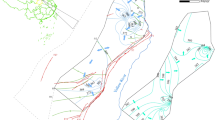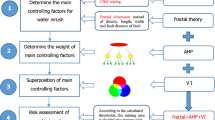Abstract
In the case of multi-seam coal mining, the earlier mined coal seam affects the engineering geological conditions of the subsequently mined coal seam, which increases the risk of mine water inrush during the subsequent coal seam mining. Previously developed evaluation methods are incapable for the risk assessment of roof water disaster due to multi-seam coal mining. Taking the first mining area of Wulunshan Coal Mine in Guizhou Province, China, as the study area, and based on the deformation and failure characteristics of the overlying strata in the coal seam during mining, an engineering geological model has been developed. There are eight controlling factors in the model, which can be used to evaluate the roof water disaster in multi-seam mining. Applying the fractal theory to quantify the geological structure, and using the AHP-EM method to determine the weights of the multiple factors, a model for the prediction and evaluation of the risk of water inrush from roof in multi-seam coal mining has been developed. A new method for the prediction and evaluation of water disaster in multi-seam coal mining has also been developed, and the risk of water inrush in the first mining area has been evaluated. The 1601 # coalface and 1603 # coalface of Wulunshan Coal Mine have been selected as the verification areas, and the results calculated by the new method have been verified as accurate and reasonable. The method can therefore provide the basis and guidance for the prevention of roof water disaster in multi-seam coal mining.








Similar content being viewed by others
Data availability
Availability of data and materials The datasets used and/or analyzed during the current study are available from the corresponding author on reasonable request.
References
Allegre CJ, Mouel JL, Provost A et al (1982) Scaling rules in rock fracture and possible implications for earthquake prediction. Nature 297(5861):47–49
Boroumandi M, Khamehchiyan M, Nikoudel MR (2015) Using of analytic hierarchy process for landslide hazard zonation in Zanjan Province, Iran. In: Lollino G et al (eds) Engineering geology for society and territory: landslide processes, vol 2, pp 951–955
Chekan G J, Listak J M. (1993). Design practices for multiple-seam longwall mines. Information Circular 9360. US Bureau of Mines, Pittsburgh PA, 35.
Cheng ZH, Ma HF, Sang C et al (2019) Experimental research on dynamic evolution characteristics of roof movement and mining-induced stress of superimposed mining in a close distance coal seam group. Geotech Geol Eng 39:1–12
Cheng XG, Qiao W, Li L et al (2020) Model of mining-induced fracture stress-seepage coupling in coal seam over-burden and prediction of mine inflow. J China Coal Soc 45(8):2890–2900
Dom NC, Ahmad AH, Latif ZA, Ismail R (2016) Application of geographical information system-based analytical hierarchy process as a tool for dengue risk assessment. Asian Pacif J Trop Dis 6(12):928–935
Gao YF (1996) "Four-zone" model of rockmass movement and back analysis of dynamic displacement. J China Coal Soc (1):51–56
Hamid T, Al-Jumeily D, Mustafina J (2018) Evaluation of the dynamic cybersecurity risk using the entropy weight method. In: Dastbaz M et al (eds) Technology for Smart Futures, pp 271–287
King G (1983) The accommodation of large strains in the upper lithosphere of the earth and other solids by self-similar fault systems: the geometrical origin of b-Value. Pure Appl Geophys 121(5-6):761–815
Li YL (2010) A case study on methods and application of yao qiao mine water disaster based on multi-information fusion assesment. China University of Mining and Technology, Beijing
Li XQ (2011) Study on the inrush mechanism of the water in bed separation due to repeated coal mining under hard rock. Ph.D. Dissertation. China University of Mining and Technology
Li P (2018) Mine Water Problems and Solutions in China. Mine Water Environ 37(2):217–221
Li B, Chen Y (2016) Risk Assessment of coal floor water inrush from underlying aquifers based on GRA–AHP and its application. Geotech Geol Eng 34(1):143–154
Li P, Qian H, Wu J (2011) Application of set pair analysis method based on entropy weight in groundwater quality assessment-a case study in Dongsheng City, northwest China. E-J Chem 8(2):851–858
Li P, Wu J, Tian R, He S, He X, Xue C, Zhang K (2018) Geochemistry, hydraulic connectivity and quality appraisal of multilayered groundwater in the Hongdunzi Coal Mine, Northwest China. Mine Water Environ 37(2):222–237
Liu TQ (1995) Influence of minging activities on mine rockmass and control engineering. J China Coal Soc 020(001):1–5
Liu SL, Li WP (2019) Fuzzy comprehensive risk evaluation of roof water inrush based on catastrophe theory in the Jurassic coalfield of northwest China. J Intell Fuzzy Syst 37(2):2101–2111
Lu Q, Li X, Li W, Chen W, Li L, Liu S (2018) Risk evaluation of bed-separation water inrush: a case study in the Yangliu Coal Mine, China. Mine Water Environ 37(2):288–299
Lu W, He C, Zhang X (2020) Height of overburden fracture based on key strata theory in longwall face. PLoS One 15(1):e0228264
Palchik V (2003) Formation of fractured zones in overburden due to longwall mining. Environ Earth Sci 44(1):28–38
Qian MG, Miao XX, Xu JL (1996) Theoretical study of key stratum in ground control. J China Coal Soc 021(003):225–230
Qian MG, Shi PW, Xu JL (2010) Mining pressure and strata control. China University of Mining and Technology Press, Xuzhou
Qiao W, Huang Y, Yuan Z et al (2014) Formation and prevention of water inrush from roof bed separation with fullmechanized caving mining of ultra-thick coal seam. Chin J Geotech Eng 33(10):2076–2084
Qiao W, Li W, Zhang X, Niu Y, Chen Y, Wang Y, Xing T (2019) Prediction of floor water disasters based on fractal analysis of geologic structure and vulnerability index method for deep coal mining in the Yanzhou mining area. Geomatics, Natural Hazards Risk 10(1):1306–1326
Saaty TL (1977) A scaling method for priorities in hierarchical structures. J Math Psychol 15(3):234–281
Saaty TL, Kearns KP (1985) The analytic hierarchy process. McGraw-Hill, New York
Saaty TL, Vargas LG (2012) Models, methods, concepts & applications of the analytic hierarchy process. Springer Science & Business Media, New York
Shannon CE (1948) A mathematical theory of communications. ATT Tech J 27(3):379–423
Shen W, Dou LM, He H, Zhu GA (2017) Rock burst assessment in multi-seam mining: a case study. Arab J Geosci 10(8)
Turcotte DL (1986) A fractal model for crustal deformation. Tectonophysics 132(1):261–269
Velandia F, Bermudez MA (2018) The transpressive southern termination of the Bucaramanga fault (Colombia): insights from geological mapping, stress tensors, and fractal analysis. J Struct Geol 115:190–207
Venticinque G, Nemcik J, Ren T et al (2014) A new fracture model for the prediction of longwall caving characteristics. Int J Min Sci Technol 24(3):369–372
Wang G, Wu M, Wang R, Xu H, Song X (2017) Height of the mining-induced fractured zone above a coal face. Eng Geol 216:140–152
Wang D, Wu J, Wang Y, Ji Y (2020) Finding high-quality groundwater resources to reduce the hydatidosis incidence in the Shiqu County of Sichuan Province, China: analysis, assessment, and management. Expo Health 12(2):307–322
Woropay M, Bojar P, Muslewski L et al (2012) Use of Analytic hierarchy process for assessment of transport system operation safety. In: Mathew J et al (eds) Engineering Asset Management and Infrastructure Sustainability, pp 1077–1087
Wu Q (2013) Handbook of mine prevention and cure water disaster. China Coal Industry Publishing House, Beijing, pp 676–680
Wu Q (2014) Progress, problems and prospects of prevention and control technology of mine water and reutilization in China. J China Coal Soc 5:795–805
Wu Q, Huang XL, Dong DL et al (2000) “Three maps-two predictions” method to evaluate water bursting coditions on roof coal. J China Coal Soc 01:62–67
Wu Q, Liu YZ, Liu Y (2011) Using the vulnerable index method to assess the likelihood of a water inrush through the floor of a multi-seam coal mine in China. Mine Water Environ 30(1):54–60
Wu Q, Wu XY, Liu SQ et al (2012) Prediction and prevention of roof water inrush in Hulusu coal mine based on “three maps-two predictions” method. In: National Coal Mining Machinery Safety Equipment Technology Development Forum and the New Product Technical Exchange, pp 542–546
Wu J, Li P, Qian H, Chen J (2015) On the sensitivity of entropy weight to sample statistics in assessing water quality: statistical analysis based on large stochastic samples. Environ Earth Sci 74(3):2185–2195
Wu Q, Xu K, Zhang W (2016) Further research on “three maps-two predictions” method for prediction on coal seam roof water bursting risk. J China Coal Soc 41(06):1341–1347
Xu L (2018) Study on the development rule of “three zones” on the roof of 1805 working face in Wulunshan Mine. Guizhou University
Yang YG, Li BT, Shang KQ et al (1998) Fuzzy comprehensive evaluation of water gush and its prediction in coal mines of Hebi mining bureau. J China Univ Min Technol 02:95–99
Zeng Y, Wu Q, Liu S, Zhai Y, Lian H, Zhang W (2018) Evaluation of a coal seam roof water inrush: case study in the Wangjialing coal mine, China. Mine Water Environ 37(1):174–184
Zhang M, Shimada H, Sasaoka T, Matsui K, Dou L (2014) Evolution and effect of the stress concentration and rock failure in the deep multi-seam coal mining. Environ Earth Sci 72(3):629–643
Zhao TB, Guo WY, Tan YL, Yin YC, Cai LS, Pan JF (2018) Case studies of rock bursts under complicated geological conditions during multi-seam mining at a depth of 800m. Rock Mech Rock Eng 51(5):1539–1564
Zou ZH, Yun Y, Sun JN et al (2006) Entropy method for determination of weight of evaluating indicators in fuzzy synthetic evaluation for water quality assessment. J Environ Sci-China 18(5):1020–1023
Acknowledgements
The authors thank the reviewers for their helpful comments.
Funding
The research was supported by the Fundamental Research Funds of the National Natural Science of China (Grant 41772302), and the Priority Academic Program Development of Jiangsu Higher Education Institutions. This work was also supported by the Postgraduate Research & Practice Innovation Program of Jiangsu Province (Grant KYCX21_2323).
Author information
Authors and Affiliations
Contributions
Xianggang Cheng performed implementation and organized the field test, and wrote the manuscript. Wei Qiao participated in drafting the manuscript and revised the manuscript. Guofa Li and Zequan Yu collected and analyzed the data.
Corresponding authors
Ethics declarations
Competing interests
The authors declare no competing interests.
Additional information
Responsible Editor: Murat Karakus
Highlights
• The manuscript promoted a new method for the prediction and evaluation of water disaster in multi-seam coal mining, which can provide the basis and guidance for the prevention of roof water disaster in multi-seam coal mining.
• An engineering geological model has been developed by on the deformation and failure characteristics of the overlying strata in the coal seam during mining, and some controlling factors were put forward to evaluate the roof water disaster in multi-seam mining.
• Applying the fractal theory to quantify the geological structure at Wulunshan Coal Mine.
• The 1601 # coalface and 1603 # coalface of Wulunshan Coal Mine have been selected as the verification areas, and the results calculated by the method have been verified as accurate and reasonable.
Rights and permissions
About this article
Cite this article
Cheng, X., Qiao, W., Li, G. et al. Risk assessment of roof water disaster due to multi-seam mining at Wulunshan Coal Mine in China. Arab J Geosci 14, 1116 (2021). https://doi.org/10.1007/s12517-021-07491-8
Received:
Accepted:
Published:
DOI: https://doi.org/10.1007/s12517-021-07491-8




